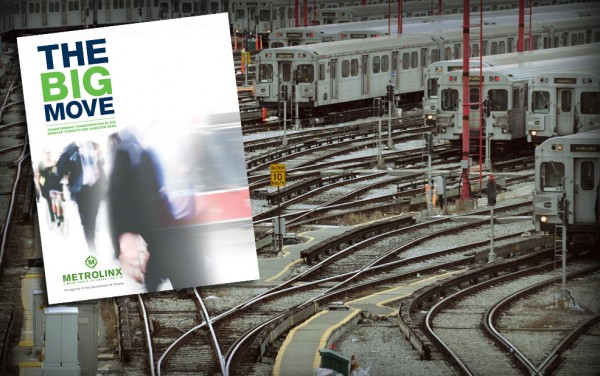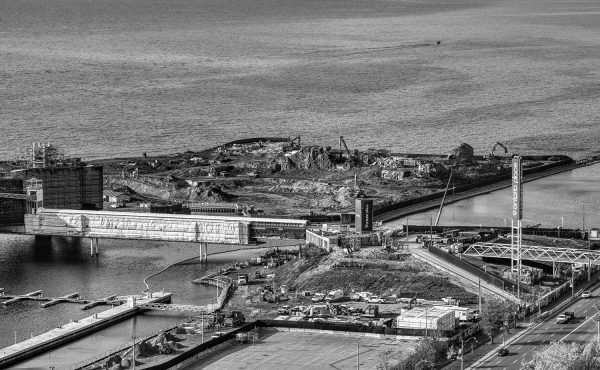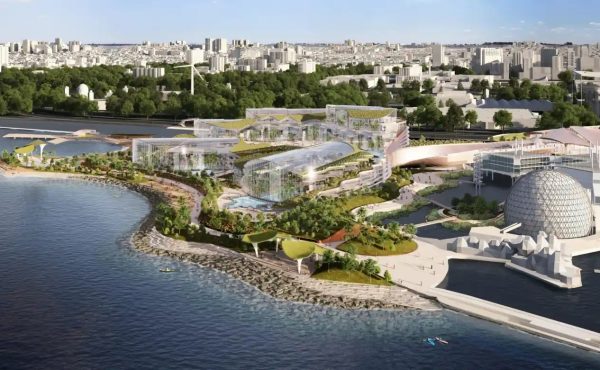
This is the second of two columns by John Lorinc today as Metrolinx announces the revenue tool recommendations for The Big Move. Read the earlier column on GTHA attitudes towards transit revenue tools released by Spacing and Innovative Research.
![]()
It is a balancing act both as daring and intricately planned as the one performed by Nik Wallenda over Niagara Falls last year. The Metrolinx investment strategy, formally released this morning after an interminable wait, is a case study in meticulous stakeholder accommodation, and looks impressively like the two best examples from elsewhere: Greater Vancouver’s Metrolinx, and Los Angeles County’s Measure R initiative.
Beginning with the premise that there’s a need for $2 billion in new taxes, the agency nonetheless put forward a plan that places a portion of the burden on businesses and developers (throw to Andrea Horwath), ensures that the projects to be financed with these new revenues are fairly divvied up between the 416 and the 905 (throw to Mississauga Mayor Hazel McCallion), kicks back a portion of the proceeds to municipalities to spend as they wish (throw to local politicians), includes various taxpayer accountability measures (throw to Tim Hudak, if he’s paying attention), and, lastly, provides a smart recommendation for a mobility tax credit for low-income residents as a way of offsetting the proposed HST increase (throw to, well, Andrea Horwath).
In the board meeting this morning where the report was approved, director after director stepped up to laud its balanced approach, including the usual cast of civic worthies and former partisans like Rae-era NDP cabinet minister Frances Lankin and Harris-era cabinet minister Janet Ecker.
As was widely reported over the weekend, Metrolinx is recommending a 1% increase in the HST, which will generate $1.3 billion per year; a 5-cent/litre fuel and gasoline tax ($330 million); a business parking levy (or about 25-cents/space/day, to generate $350 million) and a 15% increase to development charges ($100 million). As well, Metrolinx is calling to HOTs, paid parking at transit stations and land value capture.
The agency has estimated that for the average household, the annual outlay will amount to $477, although that figure could be much lower for those who don’t drive frequently and take transit (e.g. seniors and students) but as high as almost $1,000 for families that depend heavily on their car(s).
About 41% of the revenues will comes from inside the 416 and the 416, in turn, will receive about 42% of the project funding. Likewise, the 905 will contribute 59% of the revenue in exchange for 58% of the spending.
But while Metrolinx Bruce McCuaig said that some of the revenue will be hived off for the agency’s “share” of operating costs, the question of who covers the shortfalls over the long run remains murky, and is almost certainly a topic that will continue to dog the debate over how to expand transit across the GTHA.
Much will now depend on the political and legislative process that plays out over the next year or so.
Senior Queen’s Park sources told Spacing last week that the government hopes to table legislation implementing the new revenue tools in time for next spring’s budget. The legislation, which lays out both new taxes and spending, would be subject to a non-confidence motion by the opposition parties. In other words, the Liberals may face defeat over this agenda item within a year, setting the stage for both the municipal and provincial elections scheduled for 2014.
In the interim, the source said, the government will create an advisory panel to review Metrolinx’s recommendations and conduct further public and stakeholder consultations. But because municipal councils will have the authority to impose the parking tax and new development levies, the government will have to make changes to the provincial planning statement and the development charges legislation to ensure that these measures don’t get sidelined by obstructionist councils (you know who you are) or large property owners (ibid).
In a scrum after the board meeting end, McCallion, who appears to be speaking for the region’s municipalities in the absence of Mayor Rob Ford, said in no uncertain terms that she’s deeply concerned about the fate of this plan, given the political situation at the Pink Palace (my words, not her’s).
“Metrolinx has done its job,” she said, praising the report’s proposals. “Now it’s gone to the political realm, at Queen’s Park. What are they going to do? It’s going to take the local politicians and the public to tell Queen’s Park, get on with the job.”





7 comments
Metrolinx job now is to sell the plan to the municipalities and the public and encourage them to express their views to councillors and MPPs as well as party leaders.
There is huge need for education, public engagement and many more roundtables as part of this never-ending “Big Conversation” in the GTHA (and indeed, the Greater GTHA … St. Catherines, Niagara and Waterloo regions are going to need investments in the near future too).
Cheers, Moaz
I am very pessimistic about this. Most people want improvements to infrastructure, but few want to put any money into the process unless it’s someone else’s money.
I was shocked that 5% gas tax is so low, but with some wild guesses that number (330m) actually seems reasonable.
And 477 per household will sounds like a lot to many people, but I think of it like this: If time is money (just for shits and giggles), then would you substitute a percentage of your income for an equal percentage of extra free time? Assuming that we target this appropriately so that those who cannot afford the exchange don’t suffer from it, I know I’d make that deal for myself.
From that perspective, the median household income in Ontario was 68k in 2010 so 477 is 0.7% of household income roughly. If you work 8 hours and sleep 6, you need 0.7% extra time on the remaining 10 hours for that to be an equal trade. That’s a whole 4 minutes and 12 seconds in reduced travel time for the median commute. It’s almost 6 minutes if you want to count sleep time as personal time.
The only issue is that the investment is likely to generate these results too. We’re not going to even begin to eliminate congestion with this money. If we make even a small dent, with density increases factored in over the years, they’ll have succeeded with their dough. So if 2b a year in spending reduces the median commute by 2-3 minutes each way 20 years from now, it’ll be an enormous success for the money, but certainly won’t feel like it.
Apologies for the ridiculous post. 😀
My problem is the province and the feds, having passed many other tax increases saying it would go to “infrastructure growth” when nothing grew.
1 in 6 Canadians live in the GTA (Toronto and greater toronto)
1 out of every 2 new Canadians will end up living in the GTA, this huge influx is due to the governments open door immigration on Canada.
So feds pay up. Oh and by feds, I mean you know how 1/6th of the tax dollars you have come from the GTA alone, invest back.
Thank you
Given the “tremendous support” this is getting from the people, I don’t think this is going to work out. We are not going to get the funding required, and the transit development in GTHA will keep limping along, at pace much slower than projected by “big move”. And that is not necessarily a bad thing. I am never sure if extending high-order mass transit deep into suburb would be a good thing anyway. It will just enable people to move farther away seeking for large lot and large house, and still have a commute comparable to today.
What can work though, is for municipalities to take immediate and drastic steps to encourage both residential and employment development along existing and under construction transit lines. Allowing mid-rise wood-frame construction, preferential development charge for suitable sites, curb the ability for NIMBYs to delay or derail development, etc. Basically let mid-rise mixed development along avenues that meets design guideline and density target fly through approval process with minimal hassle. This will does absolutely nothing to help people who choose to live 35 km from work, but will allow people to have a choice living closer to work and have better access to existing transit. Building a more compact city is way better than building infrastructure that allow people to travel fast in a sprawling city. The political grid-lock about transit-funding may actual force things to move in the direction of the former.
Just a few more word: congestion will NOT get better. It is at its current level because people can bear it. The minute you reduce it, more people will move further away and drive more until the congestion is back to current level. The only thing that can change that equation is big jump in the cost of driving.
The realistic goal is to allow more people to have the choice of shorter, less stressed commute when the congestion is held steady at current level.
Me too, apologize for my ridiculous post 🙂
I think this list is somewhat more fair than the list that had been pushed by the Board of Trade a few weeks ago, though I do think the developer charge increase should have been more substantial. Many of the distance based “revenue tools” (such as tolls on 400 highways) that initially were proposed were extremely unfair, would have resulted in significant land re-evaluation across the region, and guaranteed that the Liberals would have lost power. While I do believe more money needs to be spent on transit, I think the growth targets for the GTA are based on targets that actually will be HARMFUL to anybody that works for a living giving the anemic employment growth in the region. Population growth without corresponding job growth, is a recipe for increasing income inequality. I trust that people will not see this statement as anti-immigration. But I am saying we need to go back to the immigration system that was in place before Mulroney, where immigration rates were tied to job growth. Mulroney made the change in response to pressure primarily from the development industry and banks. The result has been worsening economic prospects for immigrants (since they are no longer coming into a bouyant job market), a tremendous oversupply of labor (thereby worsening conditions for those who work), and more pressure on infrastructure with lessening ability to tax to finance the needed additional infrastructure (such as transit) since the strong jobs that used to fund the public realm are disappearing. When half of those employed in the GTA/Hamilton area are employed in “precarious jobs” (as a recent study showed), unemployment/underemployment persistently high, the manufacturing sector severely diminished, and job growth continues to be anemic, why do the province’s growth targets make sense? They don’t — other than as providing conditions that maximize profits for developers, banks, and corporations premised on cheap labour.